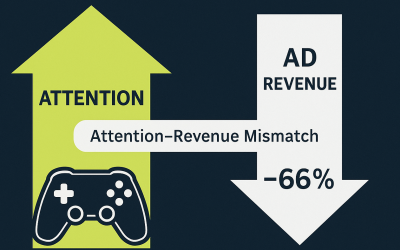CPM and CPA Pricing Methods in Video Ads
The reality is, Banner & Video Ads help run the Web. Ads support all the free services and contents we enjoy on the web; including games. There are several Ad formats – video, several banner formats, etc.
In this post, I want to quickly touch on the models of Ads AppLixir Video Ad platform serves (CPM and CPA or CPI) and how these models affect pricing.
CPM and CPA represent different pricing methods in advertising, placed by mobile ad platforms (a bit of shameless self-promotion). CP in those acronyms stands for “Cost Per…” There are different types of things different advertisers choose to pay for and so there are different pricing methods – a number of times an ad is viewed, a number of times users purchase something after watching an ad, a number of times an ad is clicked among much more. In this piece, we will take a closer look into CPM and CPA pricing methods.
CPM
Cost per thousand (CPM) denotes the price of 1,000 advertisement impressions on one webpage. If a website publisher charges $2.00 CPM, that means an advertiser must pay $2.00 for every 1,000 impressions of its ad. The “M” in CPM represents the Roman numeral for 1,000. CPM is one of the most used and one of the oldest methods for pricing the selling and buying of ad inventory.
CPM calculation considers several factors but major variables affecting CPM are
Geo Location:
Geo Location refers to the geographic location where the audience views a video or advertisement. This can include country, region, city, or even more precise locations like neighborhoods or postal codes. Understanding geo location is crucial because it helps marketers target content more effectively, understand regional preferences, and comply with local regulations. For example, an ad campaign might perform differently in urban areas compared to rural areas, and geo location data helps optimize these strategies.
Engagement Rate:
Engagement rate is a metric used to measure the level of interaction that users have with content, especially on social media and in digital marketing. It is typically calculated by taking the total number of engagements (likes, shares, comments, etc.) and dividing it by the number of impressions or views, then multiplying by 100 to get a percentage. A high engagement rate indicates that the audience finds the content interesting and is actively interacting with it, which can be a strong signal of content effectiveness.
Click Rate:
Click rate, often referred to as click-through rate (CTR), is the percentage of viewers who click on a link or advertisement out of the total number who view it. This metric is essential in digital marketing as it helps determine how compelling an advertisement or email campaign is to the audience. A higher click rate suggests that the content is relevant and enticing to viewers, leading to more traffic to the desired destination.
View Complete Rate:
View complete rate is the percentage of times a video or an ad is watched from the beginning to the end out of the total number of plays. This rate is a key performance indicator in video marketing, as it shows how engaging and captivating the video content is. High completion rates often indicate that the content is well-targeted and interesting enough to hold viewers’ attention till the end.
Contiuning on CPM and CPA Pricing Methods in Video Ads post,
Player Size:
Player size refers to the dimensions of the video player in which a video ad or content is displayed on a digital platform. This can significantly affect the viewer’s experience and engagement levels. For instance, larger player sizes can lead to higher engagement and view completion rates because the content is more visible and immersive. However, the optimal player size might vary based on the device (desktop, tablet, or mobile) and context of viewing.
Video Quality:
Video quality pertains to the resolution and bitrate of video content, which affects how clear and smooth the video appears to viewers. High-definition (HD) and ultra-high-definition (UHD) videos are likely to engage users more effectively than lower-quality videos because they provide a better viewing experience. However, marketers must balance video quality with the average internet speeds of their target audience to minimize buffering and technical issues.
Content Quality:
Content quality refers to how well the video or advertisement meets the audience’s expectations in terms of relevance, informativeness, entertainment value, and production standards. High-quality content is typically well-researched, well-produced, and precisely targeted to the audience’s interests and needs. This leads to higher engagement, retention, and conversion rates, as viewers are more likely to appreciate and react positively to superior content.
Audience Quality:
Audience quality assesses the value of the audience engaging with the content, based on factors like their likelihood to purchase, influence, or engage further with a brand. High-quality audiences are typically characterized by high engagement rates, strong purchasing power, and a genuine interest in the brand or product. Marketers aim to attract high-quality audiences by using targeted strategies and high-quality content.
Month of the Year:
The month of the year is a significant temporal factor that can influence marketing effectiveness and consumer behavior. Certain months can trigger seasonal buying patterns, such as increased shopping during December for the holidays or a spike in travel bookings during summer months. Understanding these patterns allows marketers to tailor their campaigns to coincide with when consumers are most likely to make purchasing decisions.
Day of the Month:
The day of the month can affect consumer behavior and marketing results due to payday cycles, billing dates, and other monthly financial routines. For example, consumer spending tends to increase after payday or at the beginning of the month. Marketers might time their campaigns to align with these days to maximize impact and conversion rates.
Sales Channel (Direct, Network, or Exchange):
The sales channel refers to the path through which a product or service is sold to customers. Direct channels involve selling directly to the consumer without any intermediaries. Network channels involve partnerships with other businesses to reach customers, such as through affiliate marketing or reseller arrangements. Exchanges are platforms where advertisers and publishers make ad space available for automated buying and selling, often used in programmatic advertising. Each channel has different characteristics, costs, and levels of control over the marketing process.
Audience Makeup:
Audience makeup refers to the demographic, psychographic, and behavioral characteristics of the audience that a marketer targets. This includes age, gender, income levels, interests, preferences, and purchasing behavior. Understanding the audience makeup is crucial for creating content that resonates with the target audience and for choosing the most effective channels and strategies for reaching them.
Here are the Average CPMs we are seeing across different regions
CPA
CPA stands for “Cost per Action”, and it represents the pricing model where advertisers get to pay for each specified action. For example – an action after the watching an Ad, (ex. visiting the website, rating the product, installing a new app or submitting personal information). It all depends on the type of app and the ad campaign.
Some of the other pricing methods advertisers use in modern ad world are CPI and CPC. CPI represents “Cost per Install” and it’s basically a more specified version of CPA. CPC stands for “Cost per Click” and here advertisers pay for every time their ads get clicked.
These types of Ads do pay more than CPM but come with a catch. If your site has a good Click-through and conversion, you can easily double your Ad revenue by using this Ad Model. If your site has a less than average CTR, you will be much better off with CPM ads.
There are different ways to approach video advertising and general in-app advertising. Properly placed ads and properly developed advertising campaign can help you generate great revenue from ads. Every pricing method has its own advantages and disadvantages, what makes them generate revenue is the campaign behind it.
AppLixir can help you understand the best ways to monetize your app. Visit us at www.applixir.com



